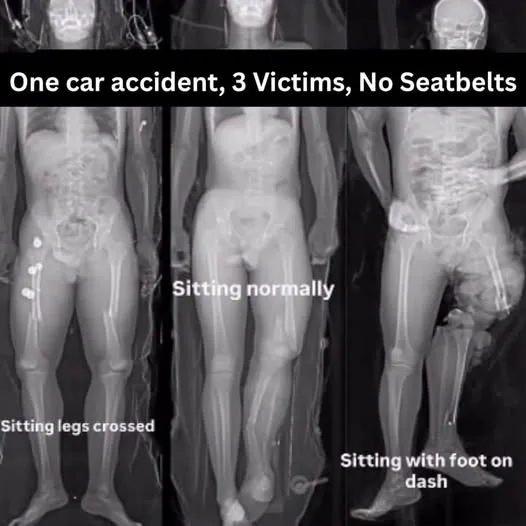Most of us have done it at least once.
You’re the passenger on a long road trip. Your shoes come off, your feet go up on the dashboard, and you lean back thinking, “It feels so good to stretch out.” Or maybe you cross one leg over the other because it’s more comfortable than sitting like a school kid. Or you recline the seat way back, slouch down, and scroll on your phone because “we’re only doing 80 km/h on a quiet road.”

It feels harmless. Until the moment it isn’t.
In a moderate to severe frontal collision — the kind that happens thousands of times a day around the world — the way you’re sitting will decide whether you walk away, spend years in rehabilitation, or never leave the hospital at all.
This isn’t speculation. It’s physics, biomechanics, and decades of real crash data from the U.S., Europe, Australia, Japan, and right here in Southeast Asia.
Let’s look at the three most dangerous “comfortable” postures — and exactly what happens to the human body when an airbag and 3,000 kg of metal meet them at 50–80 km/h.
Posture #1: Feet on the Dashboard
This is the one we see most often in Cambodia, Thailand, and Vietnam — especially on long inter-province trips. Feet up, knees bent, sometimes even holding a phone or a snack.
What happens in 0.1 seconds when the airbag explodes out at 300 km/h:
- The airbag is not a soft pillow. It’s a nylon bag filled with hot gas that punches out with up to 2,000–3,000 kg of force.
- Your knees, which were relaxed in front of the dash, are now violently driven upward and backward.
- The femurs (thigh bones) become pistons. They slam through the hip sockets, shattering the pelvis into multiple pieces.
- In many documented cases, the broken femurs continue traveling upward — one or both can spear into the abdomen, chest, or even the face.
Real injuries from this position (all documented by trauma centers worldwide):
- Pulverized pelvis requiring years of surgeries and permanent wheelchair use
- Dislocated hips that never regain full movement
- Broken jaw, orbital bones, and lost teeth when knees hit the face
- Ruptured bladder, colon, liver, or spleen from bone fragments
- Femur fractures so severe the bone exits through the back or groin
Even if the crash itself is “only” 50 km/h, the airbag turns your own legs into weapons against your body.
Posture #2: Legs Crossed
You’re sitting normally, but one ankle is resting on the opposite knee. It feels elegant, relaxed, mature.
In a crash:
- The lower (crossed) leg has nowhere to go. It’s crushed between the seat and the intruding dashboard or footwell.
- The pelvis rotates violently because one side is no longer planted on the seat → the seatbelt can’t hold you properly.
- Common outcomes: shattered tibia and fibula, destroyed knee ligaments (ACL, PCL, MCL all gone), dislocated ankle, or spiral fractures that require metal rods for life.
Trauma surgeons call these “nightmare fractures” because even after multiple operations, many patients walk with a permanent limp and chronic pain.
Posture #3: Slouching or Seat Reclined Far Back
The “gangsta lean,” the “I’m just resting my eyes,” or the full recline to sleep.
Two deadly things happen:
- Submarining When you slouch, your hips slide forward and you slip underneath the lap portion of the seatbelt. Instead of the belt staying low across the strong pelvis, it rides up over the soft abdomen. Result → severed intestines, torn mesentery, ruptured spleen, or transected aorta. Doctors call this “seatbelt syndrome” — and it kills even when everything else is survivable.
- Head and neck trajectory With the seat reclined and your body low, your head is no longer aligned with the headrest. The airbag hits your face and neck at the wrong angle, or your head whips backward into the B-pillar or rear seat. Result → broken neck, basilar skull fracture, or traumatic brain injury.
The Position That Actually Saves Lives
It’s boring. It’s what your parents told you. But it works — every single time.
- Sit all the way back in the seat — your back and hips fully supported.
- Seat upright enough that your knees are slightly bent (you should be able to reach the pedals without stretching).
- Feet flat on the floor — never on the dash, never tucked under you, never crossed.
- Seatbelt low and snug across the hips (not the stomach).
- Headrest adjusted so the back of your head is no more than 4 cm away from it.
This position keeps your skeleton aligned the way airbags and seatbelts were designed — over 50 years of engineering and millions of crash tests.
Final Thought
We buckle up because we’re afraid of dying. But sometimes the greater danger is surviving — with a body that no longer works the way it used to.
I’ve seen the X-rays. I’ve talked to the surgeons in Phnom Penh and Bangkok who piece these people back together. They all say the same thing:
“If they had just kept their feet on the floor…”
Two seconds to sit properly. A lifetime to pay if you don’t.
Next time you get in a car — any car, any distance, any speed — ask yourself one question:
“Do I want to walk away from a crash, or be carried away?”
Feet down. Seatbelt on. Back straight.
Share this with someone you love — before they put their feet up “just for a minute.”
Safe roads, Your friend who wants you to keep your legs (and your life) intact.





